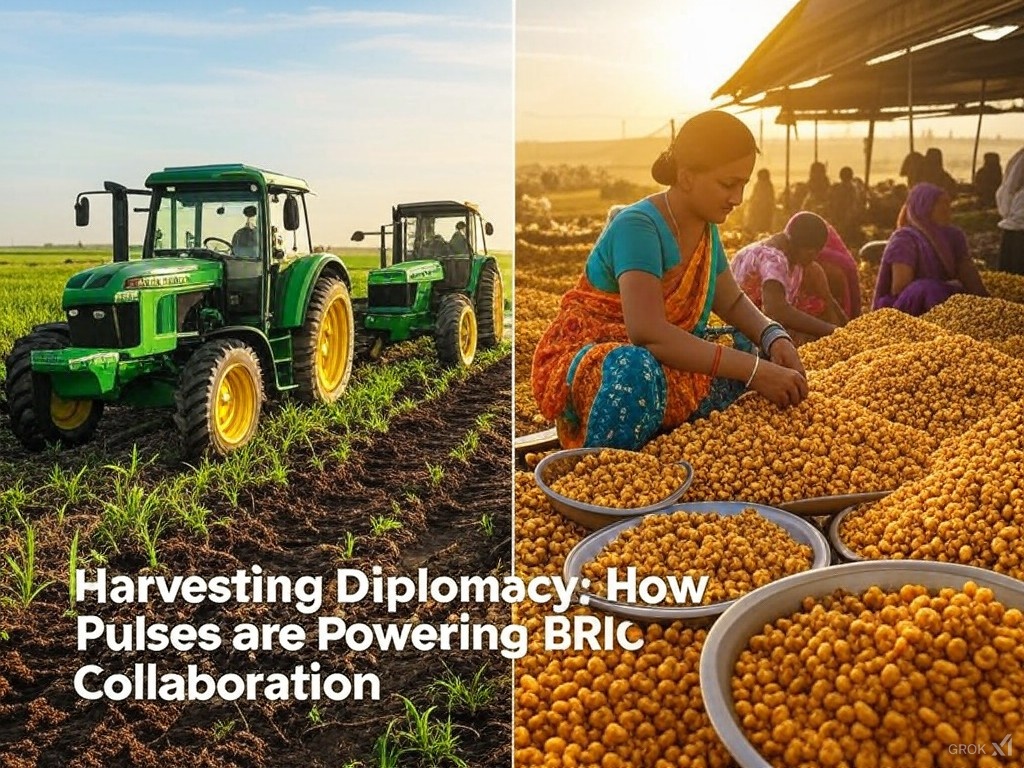
Amid global supply chain uncertainties, strategic collaboration and data-driven harvests position pulses at the heart of India-Russia economic diplomacy.
Seeds of a Strategic Partnership
In an era where climate volatility and geopolitical tensions increasingly dictate global food security, could the humble pulse emerge as an unexpected agent of international diplomacy? This question loomed large during last week’s high-stakes dialogue between Russian Deputy Minister Maxim Titov and India’s Consumer Affairs Secretary Nidhi Khare, as the two nations unveiled plans to transform their agricultural trade dynamics. With India grappling with an annual pulses deficit of 3–4 million tonnes—a gap that impacts everything from household budgets to electoral politics—the talks underscored Russia’s ascendancy as a critical supplier. Having already captured 40% of India’s lentil (masur) and 35% of yellow pea imports, Russia is now committing to diversify its agricultural output to include urad (black matpe) and tur (pigeon pea), staples that form the backbone of Indian cuisine. This collaboration, framed within the broader BRICS alliance, signals a deliberate shift away from traditional suppliers like Canada and Myanmar, reflecting India’s strategic calculus to insulate its food systems from external shocks.
Key Developments: Bridging Deficits with Data and Diplomacy
Russia’s Agricultural Ambitions Take Root
Russia’s pivot toward pulse production marks a significant evolution in its agrarian policy. Historically focused on wheat and oilseeds, the nation is now channeling state subsidies to cultivate urad and tur across the Volga and Krasnodar regions—a move aligned with India’s urgent demand. By 2026, Moscow aims to produce 2 million tonnes of these pulses annually, a target that could reduce India’s import dependency by nearly 25%. This agricultural recalibration is not merely transactional; it reflects Russia’s broader strategy to deepen economic ties with Global South nations amid Western sanctions.
Import Surges and Supply Chain Reinvention
India’s import figures for 2024 reveal a stark acceleration in trade: by early November, the country had already imported 1 million tonnes of tur and 640,000 tonnes of urad, surpassing 2023’s totals by 18% and 22%, respectively. These shipments, arriving amid improved domestic harvests, have alleviated shortages that plagued markets earlier this year. In Karnataka, unseasonal October rains accelerated tur harvesting, yielding 120,000 tonnes—a 15% increase over 2023—while Australia’s contribution of 500,000 tonnes of chana (chickpeas), delivered via 40 bulk carriers, has further stabilized supplies.
Monsoon Delays and Farmer Resilience
The story of India’s pulses supply, however, extends beyond imports. The 2024 rabi sowing season, initially delayed by prolonged monsoon rains in Maharashtra and Madhya Pradesh, has rebounded remarkably. As of January 2025, farmers have planted pulses across 85% of the targeted 15 million hectares, with mung bean (moong) leading the recovery at a 27% year-on-year increase in acreage. This resurgence, driven by favorable prices—wholesale chana rates hold steady at ₹6,200 per quintal—has injected optimism into rural economies. “The rains tested our patience, but current prices make every risk worthwhile,” remarked Vilas Patil, a farmer in Maharashtra’s Marathwada region, echoing sentiments reflected in government surveys.
Impacts and Outlook: Navigating Geopolitics and Grain Markets
Political Repercussions: BRICS Beyond Symbolism
The India-Russia pulses partnership transcends bilateral trade, offering a case study in BRICS’ evolving role as a functional economic bloc. By leveraging Russian farmland and India’s processing capabilities, the collaboration counters China’s dominance in Southeast Asian pulse markets while reducing both nations’ reliance on dollar-denominated trade channels. Domestically, the timing is pivotal: with six Indian states heading to polls in 2025, stable pulse prices could defuse opposition critiques of food inflation. The government’s crackdown on hoarding—143 raids since July 2024—underscores the political stakes of keeping kitchens affordable.
Economic Horizons: From Cost Savings to Climate Tech
Economically, diversified sourcing is projected to trim India’s annual pulses import bill by $800 million to $1 billion by 2026, according to the Indian Institute of Foreign Trade. Yet the partnership’s ambitions stretch further. Negotiations now include Russian investments in Indian agritech startups developing drought-resistant pulse varieties—a response to the erratic monsoons that delayed 2024’s rabi sowing. Meanwhile, India eyes value-added exports: plans to process and re-export 200,000 tonnes of Russian-origin pulses to Middle Eastern and North African markets by 2027 could exploit synergies via the International North-South Transport Corridor, slashing logistics costs by 30%.
The Climate Imperative
Climate resilience looms large in this evolving narrative. Karnataka’s success with early-maturing tur varieties—which reduced harvest cycles from 150 to 110 days—highlights the potential of adaptive agriculture. Such innovations, paired with Russia’s vast arable land, could position the BRICS bloc as a laboratory for sustainable food solutions. “This isn’t just about filling today’s plates,” noted agricultural economist Dr. Riya Mehta. “It’s about redesigning supply chains for a warmer, more unpredictable world.”
A Blueprint for BRICS Collaboration
As India and Russia refine their pulses partnership, the implications ripple across the Global South. The collaboration models how BRICS nations can leverage complementary strengths—Russia’s agricultural capacity and India’s market heft—to address shared vulnerabilities. With government reserves of tur and urad now at 2.3 million tonnes (an 8-month buffer), and farmer sentiment buoyed by remunerative prices, the alliance has achieved a rare equilibrium between immediate needs and long-term strategy. Yet challenges persist: global price volatility, climate shocks, and geopolitical friction could test this nascent framework. For now, though, the humble pulse stands as a testament to the power of strategic foresight—and a reminder that food security, often invisible in grand diplomatic narratives, remains the bedrock of national stability.



